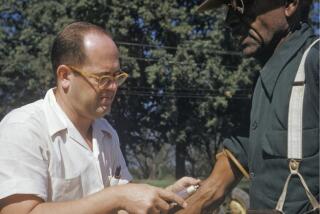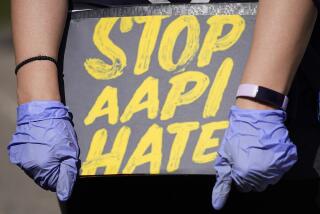Racial stereotypes and social status
Barack Obama’s election as president may be seen as a harbinger of a colorblind society, but a new study suggests that derogatory racial stereotypes are so powerful that merely being unemployed makes people more likely to be viewed by others -- and even themselves -- as black.
In a long-term survey of 12,686 people, changes in social circumstances such as falling below the poverty line or being sent to jail made people more likely to be perceived by interviewers as black and less likely to be seen as white. Altogether, the perceived race of 20% of the people in the study changed at least once over a 19-year period, according to the study published today in the Proceedings of the National Academy of Sciences.
Changes in racial perceptions -- whether from outside or within -- were likely concentrated among those of mixed ethnicity, researchers said.
“After [junk bond financier] Michael Milken goes to prison, he’ll be no more likely to say he’s a black person or any less likely to say he’s a white person,” said Amon Emeka, a social demographer at USC who was not involved in the study. “[U.S. Supreme Court Justice] Clarence Thomas might say he’s transcended race, but he wouldn’t say that he’s a white person, and certainly no one on the planet would say he’s a white person.”
Researchers have long recognized that a person’s race affects his or her social status, but the study is the first to show that social status also affects the perception of race.
“Race isn’t a characteristic that’s fixed at birth,” said UC Irvine sociologist Andrew Penner, one of the study’s authors. “We’re perceived a certain way and identify a certain way depending on widely held stereotypes about how people believe we should behave.”
Penner and Aliya Saperstein, a sociologist at the University of Oregon, examined data from the federal Bureau of Labor Statistics’ National Longitudinal Survey of Youth. Though the ongoing survey is primarily focused on the work history of Americans born in the 1950s and 1960s, participants have also provided interviewers with information on a variety of topics, including health, marital status, insurance coverage and race.
On 18 occasions between 1979 and 1998, interviewers wrote down whether the people they spoke with were “white,” “black” or “other.”
The researchers found that people whom the interviewers initially perceived as white were roughly twice as likely to be seen as nonwhite in their next interview if they had fallen into poverty, lost their job or been sent to prison. People previously perceived as black were twice as likely to continue being seen as black if any of those things had happened to them.
For example, 10% of people previously described as white were reclassified as belonging to another race if they became incarcerated. But if they stayed out of jail, 4% were reclassified as something other than white.
The effect has staying power. People who were perceived as white and then became incarcerated were more likely to be perceived as black even after they were released from prison, Penner said.
The racial assumptions affected self-identity as well. Survey participants were asked to state their own race when the study began in 1979 and again in 2002, when the government streamlined its categories for race and ethnicity.
Of the people who said they were white in 1979 and stayed out of jail, 95% said they were white in 2002. Among those who were incarcerated at some point, however, only 81% still said they were white in 2002.
The results underscore “the pervasiveness of racial stratification in society,” said Emeka. “The fact that both beholders and the observers of blackness attach negative associations to blackness speaks volumes to the continuing impact of racial stratification in U.S. society.”
But Robert T. Carter, a professor of psychology and education at Columbia Teachers College in New York who studies race, culture and racial identity, said he wasn’t convinced that stereotypes had the power to change the perception of race.
“It’s not social status that shapes race, it’s race that shapes social status,” he said. “Stratification on the basis of racial group membership has been an integral part of our society since prior to the inception of the United States. It’s been true for hundreds of years.”
To see if the changes were the result of simple recording errors made when interviewers filled out their surveys, the researchers checked how often a participant’s gender changed from one year to the next. They found changes in 0.27% of cases, suggesting that interviewers weren’t being sloppy.
They also looked for subjects who were interviewed by the same person two years in a row. Even in those cases, the results were the same.
The researchers are examining whether other social stereotypes have a similar effect on perceived race. People who have less education, live in the inner city instead of the suburbs and are on welfare are more likely to be seen as black, Saperstein said.
“The data is really interesting, but it doesn’t allow us to say what was going on in these people’s heads,” she said. “Our story is consistent with the story that there’s implicit prejudice.”
--







